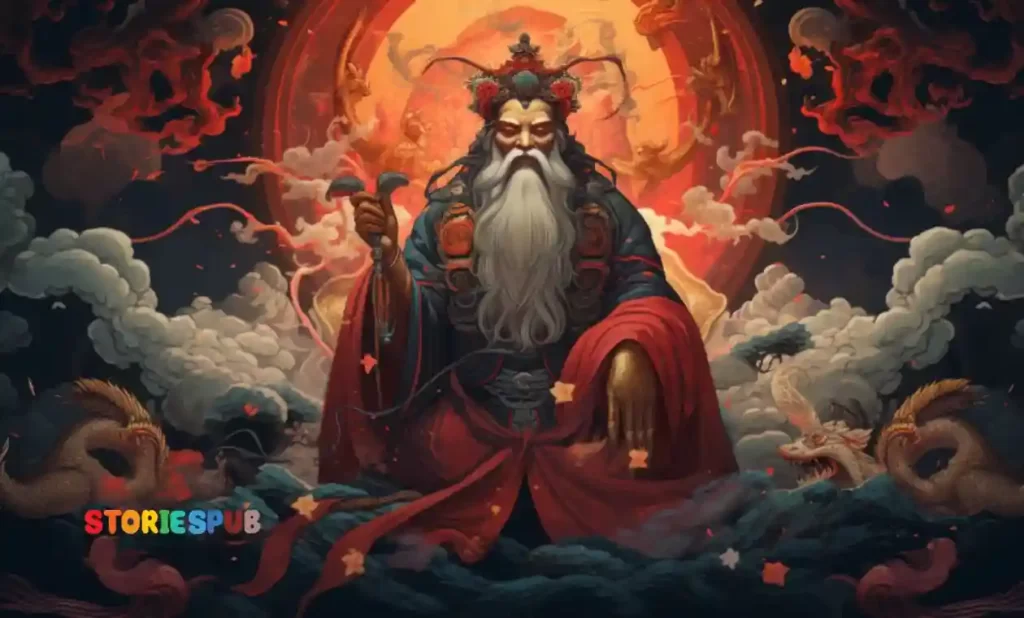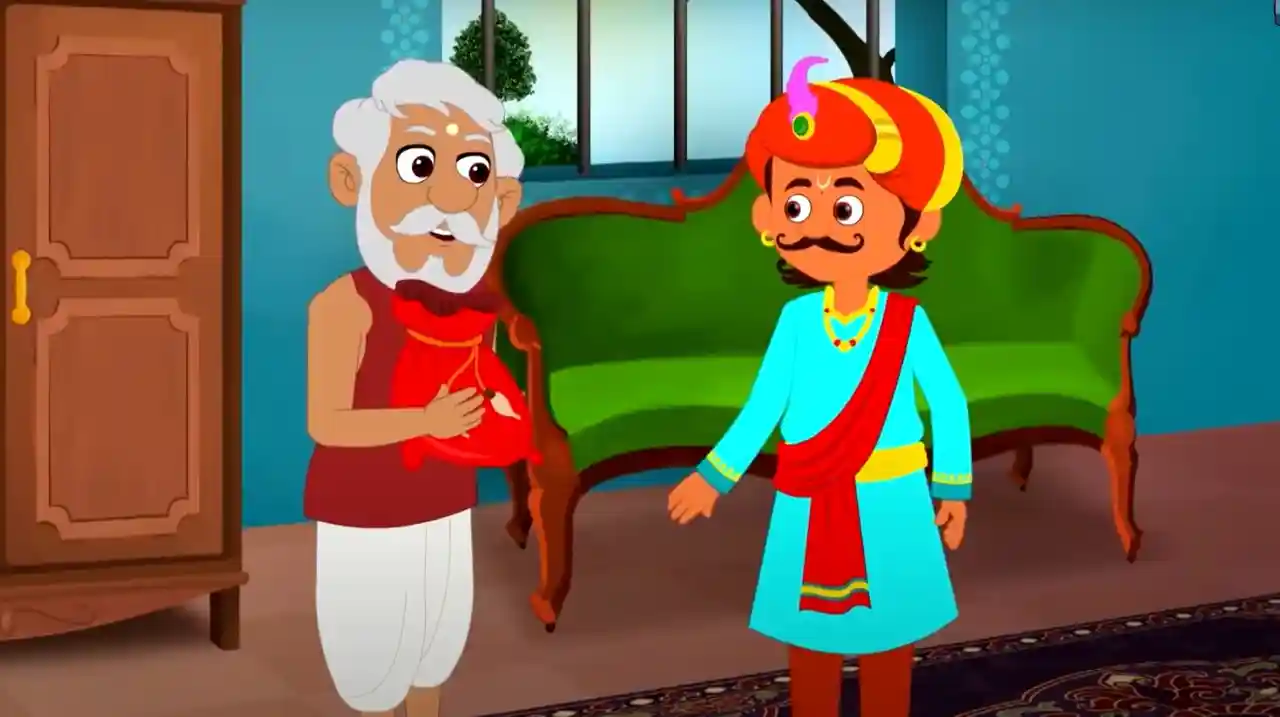Summarize this Article with:
Complete Story of Tu Di Gong – The Earth God:

Introduction
In Chinese mythology, Tu Di Gong is one of the most revered and prominent Earth Gods. He is known for his role as a protector and provider, and his worship dates back to ancient times. As a deity associated with the earth, he plays an important role in Chinese culture, particularly in the areas of agriculture and ancestor worship.
In this article, we will explore the history and significance of Tu Di Gong.
Who is Tu Di Gong?
Tu Di Gong is often depicted as a benevolent old man with a long beard, wearing traditional Chinese garb. He is associated with many things including fertility, protection from natural disasters like floods or earthquakes, and helping deceased ancestors transition to the afterlife.
According to legend, Tu Di Gong was originally a mortal man named Chen Jinggu who lived during the Yuan dynasty (1271-1368) in present-day Henan Province. Chen Jinggu was a kind-hearted man who devoted his life to helping others.
During one particularly terrible flood that threatened his village’s crops and homes, he sacrificed himself by jumping into the floodwaters to create an embankment that would protect everyone else. After his death, he became known as Tu Di Gong or “Master of Earth”.
Significance in Chinese Culture
Tu Di Gong’s importance in Chinese culture goes beyond just being an Earth God – he represents values such as sacrifice for others’ welfare, loyalty towards one’s community and ancestors’ virtues. His worship has remained significant throughout history as he was viewed through different lenses by people across various regions in China. Throughout history till modern times people visit shrines dedicated to him across China seeking divine guidance on agricultural matters such as when to plant crops or when rain will come.
Worship of Tu Di Gong
Tu Di Gong is honored in many ways. People build temples, shrines or altars to venerate him with incense and offerings such as wine, fruit and paper money. Worship of Tu Di Gong has evolved over time but the most recent evolution was when in 1986, a palace of The Earth God was built on the mountainous area of Huoshan County making it easy for devotees and tourists to come worship.
Conclusion
Tu Di Gong’s importance as an Earth God has remained significant throughout history and continues to be important today. His influence can be seen in various aspects of Chinese culture from ancestor worship to agriculture. As we delve deeper into his story, we gain an appreciation for the values he embodies and the role he plays in connecting people with their heritage.
Origins of Tu Di Gong
Legend of how he became a god after sacrificing himself to save his village from a flood
According to Chinese folklore, Tu Di Gong was once a mortal man named Wu Tao who lived in the Jiangxi Province during the Tang Dynasty. He was known for his kindness and generosity towards others, particularly the poor and needy.
One day, heavy rains caused a nearby river to overflow its banks and threaten Wu Tao’s village with flooding. In an act of selflessness, Wu Tao offered himself as a sacrifice to appease the river gods and prevent disaster from striking his home.
Moved by his sacrifice, the gods spared him from death and instead transformed him into a deity of the earth. He became known as Tu Di Gong or “Lord Earth God” and was tasked with protecting the land and its people from natural disasters such as floods, droughts, and earthquakes.
Historical context of the worship of earth gods in ancient China
The worship of earth gods has been an essential part of Chinese culture since ancient times. In early Chinese religion, deities were believed to be responsible for controlling different aspects of nature, such as wind or rain. The earth god was one such deity who held sway over the land itself.
The veneration of earth deities had practical roots in agriculture-based societies where crop yields were dependent on favorable weather conditions. Farmers prayed to these gods for bountiful harvests while also offering sacrifices in times of drought or famine.
Over time, these beliefs evolved into more complex systems involving ancestor worship and spiritual practices aimed at achieving good fortune or warding off evil spirits. The worship of Tu Di Gong became particularly prominent during China’s imperial era when emperors sought blessings from powerful deities to legitimize their rule.
Today, many Chinese continue to honor Tu Di Gong through various rituals such as offering incense or food at altars dedicated to him. His enduring popularity is a testament to the deep connections between Chinese culture, nature, and the divine.
Role and Responsibilities of Tu Di Gong
Protector and guardian of the land, crops, and people
In Chinese mythology, Tu Di Gong was believed to be a powerful deity who had control over the earth. He was often worshipped as the protector and guardian of the land, crops, and people. As such, he was considered to be an important figure in ensuring a successful harvest season.
Farmers would offer prayers and sacrifices to him in hopes that he would bless their fields with fertility and abundance. Tu Di Gong was also believed to have influence over natural disasters such as floods, droughts, and earthquakes.
As such, he was often invoked during times of crisis in order to seek his protection and aid. His role as a protector was not only limited to physical safety but also extended to spiritual well-being.
Judge of moral behavior and keeper of balance between good and evil
Another key responsibility attributed to Tu Di Gong is his role as a judge of moral behavior. He was believed to have power over life and death and could determine the fate of individuals based on their actions during their lifetime. This belief led many Chinese people in ancient times to act virtuously out of fear that they would face punishment from Tu Di Gong after death.
Tu Di Gong’s role as a judge also extended beyond individual actions; he was seen as a keeper of balance between good and evil in society. In this sense, he acted as an arbiter who ensured that justice prevailed over corruption or wrongdoing.
Connection to ancestor worship and the afterlife
Chinese culture places great emphasis on ancestor worship – the idea that one’s ancestors play an important role in shaping one’s life even after they have passed away. As such, it is not surprising that Tu Di Gong had connections with this belief system.
Accordingly, offerings made at temples dedicated to Tu Di Gong often included items such as incense, candles, and food in honor of ancestors. It was believed that by paying homage to Tu Di Gong, one could communicate with their ancestors and seek their blessings.
Moreover, Tu Di Gong was also seen as having power over the afterlife. He could help ensure that one’s ancestors found a peaceful resting place in the afterlife and protected them from negative influences.
Conclusion
Tu Di Gong’s role in Chinese mythology is multifaceted and complex. As a protector, judge, and connecter of the living with the dead, he played a vital role in defining Chinese culture over centuries. His legacy can still be felt today through the many festivals held in his honor throughout China.
Worship and Rituals Associated with Tu Di Gong
Tu Di Gong is a revered deity in Chinese culture, and there are many temples, shrines, and altars dedicated to him throughout China. These places of worship range from small roadside shrines to large, ornate temples that attract thousands of visitors each year.
The most important temple dedicated to him is the Temple of Earth (Ditan Park) located in Beijing. Devotees of Tu Di Gong offer a variety of offerings at these sites including incense, food, money, and paper effigies.
Incense is burned as a symbol of respect and to purify the area. Food such as fruits and vegetables are offered as a form of sustenance for the deity.
Money is also offered as it is believed that he can bestow wealth upon those who honor him. Paper effigies are often burned during certain festivals or ceremonies as a way to send messages or offerings to the deity.
Offerings such as incense
Incense has been used for centuries in Chinese religious practices, including those involving Tu Di Gong. It is believed that burning incense pleases the deities and purifies the area around them. Devotees will typically light incense while praying or making an offering at a shrine or temple.
The type of incense used can vary depending on the region or festival involved. Some may prefer sandalwood or jasmine-scented incense while others may choose frankincense or myrrh-scented varieties.
Food Offerings
Food offerings are another common practice associated with worshiping Tu Di Gong. Fruits such as oranges or apples are commonly given since they represent abundance and fertility.
Vegetables like lettuce can also be offered as they symbolize growth and prosperity. Meat offerings are less common, but sometimes offered to honor the deity.
However, pork is not usually given as it is thought to be impure in Chinese culture. In addition, some temples may have specific dietary restrictions on what foods can be offered.
Money Offerings
Offering money or other forms of wealth to Tu Di Gong is believed to bring good fortune and prosperity to the giver. This practice dates back centuries in China and continues today.
Money offerings are usually made by placing coins or bills on an offering table or altar at a temple or shrine. Some temples may also have donation boxes for visitors who wish to give more substantial offerings.
Annual Festivals Honoring Tu Di Gong – Qingming Festival (Tomb Sweeping Day)
One of the most significant festivals held in honor of Tu Di Gong is the Qingming Festival (also known as Tomb Sweeping Day), which falls on April 4th or 5th each year. It is a time for people to pay their respects to their ancestors by visiting grave sites and performing traditional rituals such as burning paper money or incense. In addition, many people will also visit shrines dedicated specifically to Tu Di Gong during this festival.
Offerings such as flowers, food, and incense are commonly given during these visits. Some temples may also hold special ceremonies or processions during the festival.
Overall, worshiping Tu Di Gong involves many different traditions and practices that have been passed down through generations of Chinese culture. These rituals allow devotees a way to connect with the deity and show their respect and gratitude for his protection over their land, crops, and people.
Regional Variations in Worship
The worship of Tu Di Gong is not limited to one region in China. In fact, he is worshipped throughout the country, with some variations in his name and specific rituals. Here are some of the regional differences in the worship of Tu Di Gong.
Different Names for Tu Di Gong in Different Regions
In Northern China, Tu Di Gong is often referred to as Tudi Yeye or Earth Grandpa. In Southern China, however, he is known as Tudi Ye or Earth Lord. This variation in name reflects the differences between Northern and Southern Chinese dialects.
In other regions, he may also be known by different titles depending on his specific role. For example, in some areas where he is considered a protector of children, he may be called Er Ye or Second Grandfather.
Unique Customs Associated with His Worship Such as Dragon Boat Races in Hong Kong
Hong Kong is known for its vibrant and unique traditions when it comes to worshipping Tu Di Gong. One such tradition is the Dragon Boat Festival held annually on the fifth day of the fifth lunar month.
During this festival, teams compete against each other to race their elaborately decorated dragon boats along a designated course. The festival originated from a legend about Qu Yuan – an ancient Chinese poet who drowned himself after being exiled from his homeland.
Legend has it that local villagers paddled out on their boats to save him but were too late. They then threw rice dumplings into the water both to commemorate Qu Yuan’s sacrifice and to distract any fish that might try to eat his body.
The festival has since evolved into a celebration honoring Tu Di Gong for protecting Hong Kong from floods and typhoons. Other unique customs include setting off firecrackers, burning paper offerings, and preparing special dishes to offer during the festival.
Overall, the worship of Tu Di Gong varies across China and has evolved over many centuries. However, what remains consistent is his significance in Chinese culture as a protector and guardian of the land and people.
Modern Interpretations
Continued Relevance of Tu Di Gong in Contemporary Chinese Culture
Tu Di Gong remains an important figure in contemporary Chinese culture, with his worship still practiced widely. In fact, he is considered by many to be the most popular of all Chinese gods.
The continued relevance of Tu Di Gong can be attributed to the deep historical and cultural significance of his story, as well as his role as a protector and judge. Many Chinese people believe that Tu Di Gong still has the power to influence their daily lives, and as such they offer him offerings of incense, food, and other items at temples and shrines dedicated to him throughout China.
He is especially closely associated with agriculture and farming, so farmers often seek his blessing for a good harvest. In addition to traditional worship practices, modern interpretations of Tu Di Gong have emerged in recent years.
For example, some Chinese businesses display images or statues of him in their offices or stores for good luck and prosperity. His image has also been used in advertising campaigns for various products.
Influence on Popular Media
Tu Di Gong’s story has also inspired numerous works of popular media including films, TV shows, and video games. One notable example is the 1985 Hong Kong film “Mr. Vampire,” which features a fight scene between the Earth God and a group of vampires. In recent years, Tu Di Gong has become a recurring character in various forms of media targeted at younger audiences.
For example, he appears as a character in the popular video game “League of Legends” where he is known as “The Stonewarden.” In this game he takes on various roles including a guardian deity who protects sacred temples. Despite being adapted into modern entertainment media however,Tu Di Gong’s image remains deeply ingrained within traditional Chinese culture – where it continues to serve as an important symbol of prosperity, good luck, and protection.
Tu Di Gong is a highly significant figure in Chinese mythology and culture. His story of sacrifice and devotion continue to inspire people throughout China today.
While his worship practices remain an important part of traditional religious practice,Tu Di Gong has also found new life in modern interpretations within popular media. Regardless of the cultural medium, his legacy continues to endure as a champion of the land and its people.
Conclusion
Tu Di Gong, the Earth God, is a prominent figure in Chinese mythology and continues to have a significant impact on contemporary Chinese culture. As we have seen in this article, Tu Di Gong’s origins can be traced back to ancient times when people worshipped the gods of the earth for protection and abundance.
The story of Tu Di Gong sacrificing himself to save his village from a flood is just one example of his benevolent nature. As protector and guardian of the land, crops, and people, Tu Di Gong is revered for his role in maintaining balance between good and evil.
The worship of Tu Di Gong has evolved over time but remains an integral part of many Chinese communities. Temples, shrines, and altars dedicated to him can be found throughout China.
People continue to offer incense, food, money, and paper effigies as offerings to him. Annual festivals such as Tomb Sweeping Day further exemplify the importance of Tu Di Gong in Chinese culture.
While there may be regional variations in how people worship Tu Di Gong or what rituals they practice associated with him- such as dragon boat races in Hong Kong- the central role he plays remains constant across all regions where he is worshipped. In modern times we see evidence of Tu Di Gong’s influence on popular media such as films (Jade Warrior) TV shows ( Journey to The West )and video games (Dynasty Warriors).
These forms of entertainment allow younger generations to learn about their cultural heritage while being entertained and engaged. : The story of Tu Di Gong – also known as the Earth God – has been passed down through generations for thousands of years.
He remains a symbol not only for protection but also resilience; traits that are valued not only within Chinese culture but universally so. It is clear that despite changes over time or regional differences – this god continues providing a unifying force within China by empowering and guiding its people.
Hey kids, how much did you like Complete Story of Tu Di Gong – The Earth God:? Please share your view in the comment box. Also, please share this story with your friends on social media so they can also enjoy it, and for more such Chinese Mythology, please bookmark storiespub.com.
Related Post :













